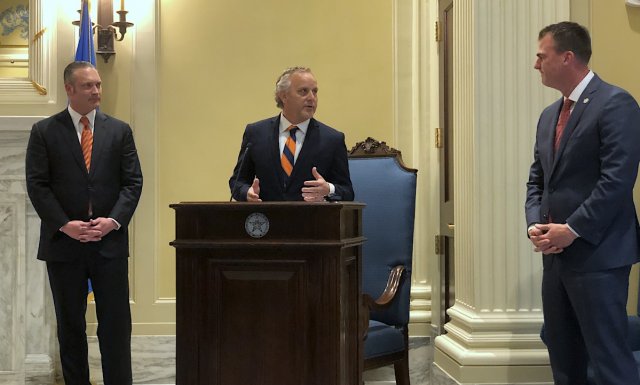
The Oklahoma Legislature will return for a fall special session to complete the congressional redistricting process and possibly tweak the legislative redistricting maps that they are constitutionally required to pass before the end of the 2021 regular legislative session.
The unusual scenario is the result of Oklahoma’s constitutional redistricting requirement and this year’s delay in the federal government’s release of 2020 U.S. Census Bureau data. States have been told to expect that data sometime this fall, months after it would typically be finalized. States adjust their legislative and congressional district boundaries based on that data every 10 years, but many states do not have a deadline for completion enshrined in their constitutions.
But the Oklahoma Constitution specifies a deadline for legislative apportionment in Article 5, Section 10:
The apportionment of the Legislature shall be accomplished by the Legislature according to the provisions of this article, within ninety (90) legislative days after the convening of the first regular session of the Legislature following each Federal Decennial Census. If the Legislature shall fail or refuse to make such apportionment within the time provided herein, then such apportionment shall be accomplished by the Bipartisan Commission on Legislative Apportionment, according to the provisions of this article.
The U.S. Census Bureau said in February that it will deliver states their census data by Sept. 30, a scenario that Senate President Pro Tempore Greg Treat (R-OKC) said has placed states like Oklahoma in a complicated position.
“The question becomes is the completion of the U.S. census when they stop counting or when they release the data to us?” Treat said in late March. “To be in compliance, we feel like we need to have legislative redistricting done this session to have sine die because the census was completed last year even though we don’t have the numbers and won’t have the numbers until sometime this fall.”
Oklahoma’s legislative apportionment process allows for a 5 percent variance in population levels among the 101 House of Representative districts and the 48 State Senate districts. That means the House and Senate’s redistricting leaders can use the U.S. Census Bureau’s 2015-2019 American Community Survey data to craft legislative districts now before the end of regular session in May. With special session looming to handle the congressional districts, lawmakers will be able to adjust any legislative districts that end up falling outside of the 5 percent variance once official 2020 census data is available.
“We will absolutely have to come into special session to do congressional redistricting because you have to have an exact number of people per district in that,” Treat said. “And then anywhere where the variances are too big in the legislative redistricting we complete this spring we can adjust those in that special session.”
Asked if he thinks special session will be a less stressful time for lawmakers to complete redistricting, Treat decided that the glass is half full.
“It’s the only option we have,” he said. “So yes, I’ll be optimistic. I think it’s going to be awesome.”
‘I am honestly interested to see what we get’
While 22 public meetings have already been held to receive feedback from Oklahomans, April should be a busy month for redistricting efforts.
Senate redistricting director Keith Beall briefed media on the process this morning, and he noted that the deadline for members of the public to submit their own maps is 5 p.m. Sunday.
“As we sit here right now, we have zero maps from the public. I do know of a few that will be submitting,” Beall said. “I actually had predicted we would get lots of public maps, so we will see what happens between now and Sunday.”
If public maps are submitted, Beall said Tuesday, April 13, will likely be the day when a public comment period is held to hear feedback about those maps.
“I thought we would get 50 to 60 maps, and we’re on pace for three, if we’re lucky,” Beall said. “I am honestly interested to see what we get.”
Rep. Ryan Martinez (R-Edmond) is coordinating redistricting efforts in the House, and he also said he wants public map submissions.
“As many people that submit who can, the better,” Martinez said. “We’re interested in hearing what the public has to say, and so far it’s going really good.”
Beall noted that, based on the census estimates available for the past 10 years, county populations have climbed around the state’s urban areas and have either dropped or underperformed overall statewide growth of 5.5 percent in many rural counties.
The OKC metro area has outpaced the Tulsa metro area as well. Based on estimates, Oklahoma County has grown 11 percent, while Canadian County, which includes Yukon, Mustang and parts of Oklahoma City, has seen a 28.3 percent population increase. Cleveland County, containing Moore and Norman, has grown 10.9 percent.
Tulsa County has grown 8 percent, while Rogers County has grown 6.4 percent.
The situation for rural counties has been much different, with Texas County in the panhandle declining in population by 3.2 percent and Pittsburg County (where McAlester is the county seat) losing 4.7 percent of its population. Carter County has seen 0.8 percent growth, and Woodward County has seen 0.6 percent growth, but both marks are far below the statewide growth of 5.5. percent.
“It’s not only an Oklahoma issue, it really is a nationwide trend you see where we are losing a lot of population in rural areas who are moving into suburban and urban areas,” Martinez said. “Kind of the silver lining is, it used to be we would lose that population and people would move to Dallas, Denver or Kansas City, but instead you see them moving into Edmond, Oklahoma City, Tulsa and staying in Oklahoma. So I do think that is a testament to some of the great things that are happening in our urban areas.”
That means at least one district in both the House and Senate is expected to shift from a rural base to an urban or suburban constituency. Martinez said he wants to hear from any Oklahoman, urban, suburban or rural.
“Contact your representative,” he said. “Contact my office. I’d really love to hear from you. The more input we get the better product we are going to have.”





















